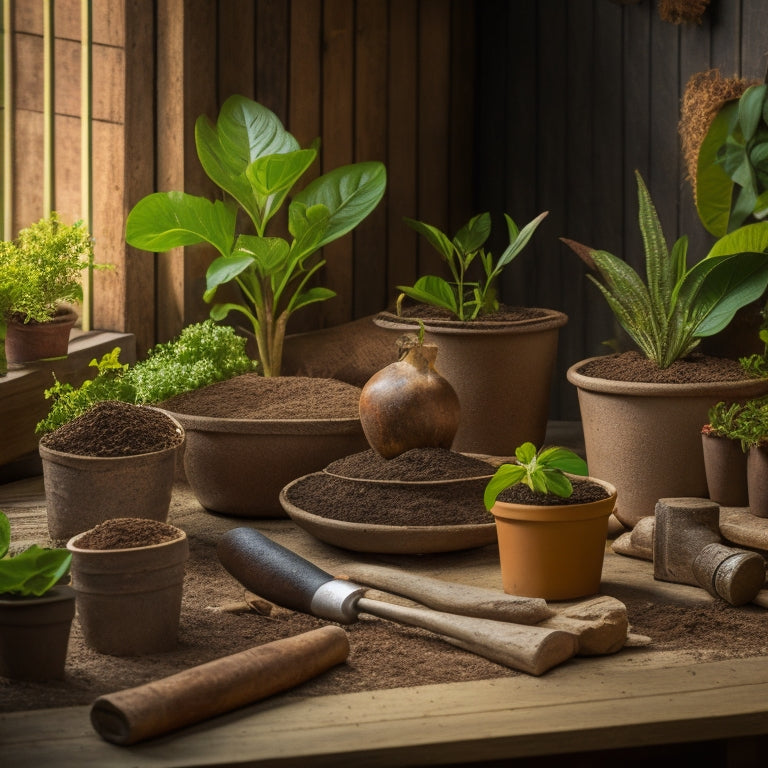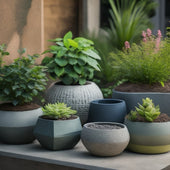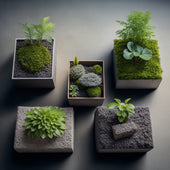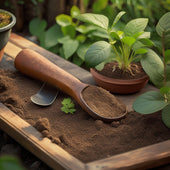
3 Best DIY Planter Budget Breakdown for Beginners
Share
As a beginner, you'll want to allocate a realistic budget for your DIY planter project. For a cinder block planter, you'll need to factor in the cost of blocks, which can range from $10 to $135 or more, depending on the design. Add to that essential tools, like a level and trowel, as well as materials like soil, plants, and decorative elements. Labor costs, including skilled and unskilled tasks, can greatly impact your budget, so estimate these expenses carefully. By prioritizing your needs and accounting for all costs, you'll be well on your way to creating a beautiful planter that fits your budget, and now it's time to get a closer look at how to make that happen.
Key Takeaways
• Estimate cinder block costs based on size, quality, and design complexity, ranging from $10 to $135 or more for a simple planter.
• Set aside a budget for essential tools like a level, trowel, and wheelbarrow, or consider borrowing or renting to reduce costs.
• Account for additional expenses like soil, plants, and decorative elements, and consider repurposing materials to save money and reduce waste.
• Labor costs can be significant, so estimate time required and hourly rates for skilled and unskilled tasks, and calculate total labor expense accordingly.
• Create a prioritized list of tools and materials to allocate your budget effectively and ensure you don't overspend on any one aspect of your DIY planter project.
DIY Cinder Block Planter Costs
When building a DIY cinder block planter, you'll need to take into account the cost of the cinder blocks themselves, which can range from $1 to $3 per block depending on the size and quality.
There are various types of cinder blocks to choose from, including standard blocks, half-blocks, and even decorative blocks with unique textures and colors. The type you choose will impact your overall cost, so it's crucial to reflect on your planter design and the number of blocks you'll need.
For a simple planter design, you might need around 10-15 blocks, which would cost between $10 and $45. However, if you're creating a more intricate design or a larger planter, you could need 20-30 blocks or more, increasing your cost to $60-$135 or more.
Additionally, you might want to take into account the cost of any additional materials, such as mortar, sand, and decorative stones, which can add to your overall expense.
Budgeting for Materials and Tools
As you plunge into your DIY planter project, set aside a budget for materials and tools, including essential items like a level, trowel, and wheelbarrow, which can add up quickly. These expenses can vary depending on your material selection and the complexity of your design. For instance, if you're using cinder blocks, you'll need to factor in the cost of mortar and sand.
Additionally, consider tool alternatives that can save you money. Instead of buying a pricey wheelbarrow, borrow one from a friend or rent it for the day.
When budgeting for materials, don't forget to account for the cost of soil, plants, and any decorative elements you want to add. You can also get creative with repurposed materials like old pallets or wooden crates to reduce waste and save money.
Make a list of the tools and materials you need, and prioritize the essentials. By doing so, you'll be able to allocate your budget effectively and avoid overspending.
With a clear plan and a realistic budget, you'll be well on your way to creating a beautiful and functional DIY planter that fits your style and budget.
Breaking Down Labor Expenses
Now that you've allocated funds for materials and tools, it's time to calculate the labor costs involved in bringing your DIY planter project to life. Labor expenses can be a significant portion of your overall budget, so it's crucial to estimate them accurately.
There are two primary labor types to take into account: skilled labor and unskilled labor. Skilled labor refers to tasks that require specialized skills, such as electrical or plumbing work, while unskilled labor involves tasks that don't require special training, like digging or hauling materials.
When estimating labor costs, reflect on the time required for each task and the hourly rate for each labor type. You can use online resources or consult with professionals to determine the average hourly rates for your area. For example, if you're building a planter that requires 10 hours of skilled labor at $50 per hour, your total labor cost would be $500.
Add up the labor costs for each task to get your total labor expense. By breaking down labor expenses into these smaller components, you'll get a more accurate estimate of your project's overall cost.
Frequently Asked Questions
Can I Use Old Pallets Instead of Cinder Blocks for Planters?
You're wondering if old pallets can replace cinder blocks for planters? Absolutely!
Pallets offer several advantages, like being eco-friendly and budget-friendly. Plus, they add a rustic charm to your garden.
As a planter material, pallets are lightweight, easy to work with, and can be easily disassembled. Just make sure to disinfect and weatherproof them before use.
With a little creativity, you can upcycle pallets into unique planters that reflect your personal style.
How Do I Prevent Weeds From Growing in My DIY Planter?
You're smart to think about weed control from the get-go!
To prevent those pesky weeds from growing in your DIY planter, you'll want to add a layer of mulch.
Opt for organic mulch options like wood chips, bark, or straw, which will break down over time and improve soil health.
Apply a thick layer, about 2-3 inches, and replenish as needed.
This will suppress weeds and retain moisture in the soil, giving your plants the best chance to thrive.
Are DIY Planters Suitable for Indoor or Outdoor Use Only?
Imagine transforming your tiny balcony into a lush oasis with a DIY planter.
Now, are you wondering if it's suitable for indoor or outdoor use only? The good news is, you can use DIY planters in both settings!
Indoor planters can thrive in a sunny windowsill or under grow lights, while outdoor planters can withstand the elements.
Just choose the right materials and plants for your environment, and you're all set to get creative!
Can I Customize My Planter's Design and Size?
You're wondering if you can customize your planter's design and size? Absolutely! You're the boss of your DIY project.
Choose planter materials that fit your style, from rustic wood to sleek metal. Find design inspiration online or get creative with unique shapes and colors.
Want a mini planter for your desk or a statement piece for your patio? You decide! The possibilities are endless, and it's all about expressing your personal taste.
Do I Need to Add Drainage Holes to My DIY Planter?
'Oh, you think your plants are invincible and can survive in a waterlogged apocalypse? Newsflash: they're not. You absolutely need to add drainage holes to your DIY planter, or risk turning it into a plant graveyard.
The importance of drainage can't be stressed enough, especially when working with materials like ceramic or wood that can retain water.
Don't be that plant parent - drill those holes and give your green friends a fighting chance!'
Conclusion
Now that you've got your DIY planter costs broken down, it's time to get creative!
As you envision your backyard oasis, ask yourself: Can you already picture the vibrant flowers spilling out of your new cinder block planter, surrounded by the warm glow of a summer evening?
With a solid budget in place, you're just a few hours away from making that vision a reality.
Related Posts
-

5 Best DIY Planter Ideas to Upcycle Concrete
You're about to breathe new life into discarded concrete blocks by transforming them into functional and visually app...
-

5 Best DIY Planter Ideas to Upcycle Concrete
You're about to breathe new life into discarded concrete blocks by transforming them into functional and visually app...
-

5 Best DIY Planter Ideas to Upcycle Concrete
You're about to breathe new life into discarded concrete blocks by transforming them into functional and visually app...
-

5 Best DIY Planter Ideas to Upcycle Concrete
You're about to breathe new life into discarded concrete blocks by transforming them into functional and visually app...
-

5 Best DIY Planter Ideas to Upcycle Concrete
You're about to breathe new life into discarded concrete blocks by transforming them into functional and visually app...
-

5 Best DIY Planter Ideas to Upcycle Concrete
You're about to breathe new life into discarded concrete blocks by transforming them into functional and visually app...
-

5 Best DIY Planter Ideas to Upcycle Concrete
You're about to breathe new life into discarded concrete blocks by transforming them into functional and visually app...
-

5 Best DIY Planter Ideas to Upcycle Concrete
You're about to breathe new life into discarded concrete blocks by transforming them into functional and visually app...
-

5 Best DIY Planter Ideas to Upcycle Concrete
You're about to breathe new life into discarded concrete blocks by transforming them into functional and visually app...
-

5 Best DIY Planter Ideas to Upcycle Concrete
You're about to breathe new life into discarded concrete blocks by transforming them into functional and visually app...
-

5 Best DIY Planter Ideas to Upcycle Concrete
You're about to breathe new life into discarded concrete blocks by transforming them into functional and visually app...
-

5 Best DIY Planter Ideas to Upcycle Concrete
You're about to breathe new life into discarded concrete blocks by transforming them into functional and visually app...
-

5 Best DIY Planter Ideas to Upcycle Concrete
You're about to breathe new life into discarded concrete blocks by transforming them into functional and visually app...
-

5 Best DIY Planter Ideas to Upcycle Concrete
You're about to breathe new life into discarded concrete blocks by transforming them into functional and visually app...
-

5 Best DIY Planter Ideas to Upcycle Concrete
You're about to breathe new life into discarded concrete blocks by transforming them into functional and visually app...
-

5 Best DIY Planter Ideas to Upcycle Concrete
You're about to breathe new life into discarded concrete blocks by transforming them into functional and visually app...
-

5 Best DIY Planter Ideas to Upcycle Concrete
You're about to breathe new life into discarded concrete blocks by transforming them into functional and visually app...
-

5 Best DIY Planter Ideas to Upcycle Concrete
You're about to breathe new life into discarded concrete blocks by transforming them into functional and visually app...
-

Why Choose the Right Blocks for Your Planters
When creating a thriving planter, you need to choose the right blocks to support the entire ecosystem. Start by evalu...
-

Why Choose the Right Blocks for Your Planters
When creating a thriving planter, you need to choose the right blocks to support the entire ecosystem. Start by evalu...
-

Why Choose the Right Blocks for Your Planters
When creating a thriving planter, you need to choose the right blocks to support the entire ecosystem. Start by evalu...
-

Why Choose the Right Blocks for Your Planters
When creating a thriving planter, you need to choose the right blocks to support the entire ecosystem. Start by evalu...
-

Why Choose the Right Blocks for Your Planters
When creating a thriving planter, you need to choose the right blocks to support the entire ecosystem. Start by evalu...
-

Why Choose the Right Blocks for Your Planters
When creating a thriving planter, you need to choose the right blocks to support the entire ecosystem. Start by evalu...
-

Why Choose the Right Blocks for Your Planters
When creating a thriving planter, you need to choose the right blocks to support the entire ecosystem. Start by evalu...
-

Why Choose the Right Blocks for Your Planters
When creating a thriving planter, you need to choose the right blocks to support the entire ecosystem. Start by evalu...
-

Why Choose the Right Blocks for Your Planters
When creating a thriving planter, you need to choose the right blocks to support the entire ecosystem. Start by evalu...
-

Why Choose the Right Blocks for Your Planters
When creating a thriving planter, you need to choose the right blocks to support the entire ecosystem. Start by evalu...
-

Why Choose the Right Blocks for Your Planters
When creating a thriving planter, you need to choose the right blocks to support the entire ecosystem. Start by evalu...
-

Why Choose the Right Blocks for Your Planters
When creating a thriving planter, you need to choose the right blocks to support the entire ecosystem. Start by evalu...
-

Why Choose the Right Blocks for Your Planters
When creating a thriving planter, you need to choose the right blocks to support the entire ecosystem. Start by evalu...
-

Why Choose the Right Blocks for Your Planters
When creating a thriving planter, you need to choose the right blocks to support the entire ecosystem. Start by evalu...
-

Why Choose the Right Blocks for Your Planters
When creating a thriving planter, you need to choose the right blocks to support the entire ecosystem. Start by evalu...
-

Why Choose the Right Blocks for Your Planters
When creating a thriving planter, you need to choose the right blocks to support the entire ecosystem. Start by evalu...
-

Why Choose the Right Blocks for Your Planters
When creating a thriving planter, you need to choose the right blocks to support the entire ecosystem. Start by evalu...
-

Why Choose the Right Blocks for Your Planters
When creating a thriving planter, you need to choose the right blocks to support the entire ecosystem. Start by evalu...
-

Why Choose the Right Blocks for Your Planters
When creating a thriving planter, you need to choose the right blocks to support the entire ecosystem. Start by evalu...
-

Why Choose the Right Blocks for Your Planters
When creating a thriving planter, you need to choose the right blocks to support the entire ecosystem. Start by evalu...
-

Why Choose the Right Blocks for Your Planters
When creating a thriving planter, you need to choose the right blocks to support the entire ecosystem. Start by evalu...
-

Why Choose the Right Blocks for Your Planters
When creating a thriving planter, you need to choose the right blocks to support the entire ecosystem. Start by evalu...
-

Why Choose the Right Blocks for Your Planters
When creating a thriving planter, you need to choose the right blocks to support the entire ecosystem. Start by evalu...
-

What Makes a Good Used Trowel for Planters
When searching for a good used trowel for planters, you'll want to prioritize corrosion-resistant materials like stai...
-

What Makes a Good Used Trowel for Planters
When searching for a good used trowel for planters, you'll want to prioritize corrosion-resistant materials like stai...
-

What Makes a Good Used Trowel for Planters
When searching for a good used trowel for planters, you'll want to prioritize corrosion-resistant materials like stai...
-

What Makes a Good Used Trowel for Planters
When searching for a good used trowel for planters, you'll want to prioritize corrosion-resistant materials like stai...
-

What Makes a Good Used Trowel for Planters
When searching for a good used trowel for planters, you'll want to prioritize corrosion-resistant materials like stai...
-

What Makes a Good Used Trowel for Planters
When searching for a good used trowel for planters, you'll want to prioritize corrosion-resistant materials like stai...
-

What Makes a Good Used Trowel for Planters
When searching for a good used trowel for planters, you'll want to prioritize corrosion-resistant materials like stai...
-

What Makes a Good Used Trowel for Planters
When searching for a good used trowel for planters, you'll want to prioritize corrosion-resistant materials like stai...
-

What Makes a Good Used Trowel for Planters
When searching for a good used trowel for planters, you'll want to prioritize corrosion-resistant materials like stai...
-

What Makes a Good Used Trowel for Planters
When searching for a good used trowel for planters, you'll want to prioritize corrosion-resistant materials like stai...
-

What Makes a Good Used Trowel for Planters
When searching for a good used trowel for planters, you'll want to prioritize corrosion-resistant materials like stai...
-

What Makes a Good Used Trowel for Planters
When searching for a good used trowel for planters, you'll want to prioritize corrosion-resistant materials like stai...
-

What Makes a Good Used Trowel for Planters
When searching for a good used trowel for planters, you'll want to prioritize corrosion-resistant materials like stai...
-

What Makes a Good Used Trowel for Planters
When searching for a good used trowel for planters, you'll want to prioritize corrosion-resistant materials like stai...
-

What Makes a Good Used Trowel for Planters
When searching for a good used trowel for planters, you'll want to prioritize corrosion-resistant materials like stai...
-

What Makes a Good Used Trowel for Planters
When searching for a good used trowel for planters, you'll want to prioritize corrosion-resistant materials like stai...
-

What Makes a Good Used Trowel for Planters
When searching for a good used trowel for planters, you'll want to prioritize corrosion-resistant materials like stai...
-

What Makes a Good Used Trowel for Planters
When searching for a good used trowel for planters, you'll want to prioritize corrosion-resistant materials like stai...
-

What Makes a Good Used Trowel for Planters
When searching for a good used trowel for planters, you'll want to prioritize corrosion-resistant materials like stai...
-

What Makes a Good Used Trowel for Planters
When searching for a good used trowel for planters, you'll want to prioritize corrosion-resistant materials like stai...
-

What Makes a Good Used Trowel for Planters
When searching for a good used trowel for planters, you'll want to prioritize corrosion-resistant materials like stai...
-

What Makes a Good Used Trowel for Planters
When searching for a good used trowel for planters, you'll want to prioritize corrosion-resistant materials like stai...
-

What Makes a Good Used Trowel for Planters
When searching for a good used trowel for planters, you'll want to prioritize corrosion-resistant materials like stai...
-

What Makes a Good Used Trowel for Planters
When searching for a good used trowel for planters, you'll want to prioritize corrosion-resistant materials like stai...


